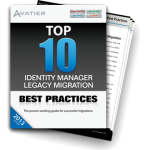Management of assets, access requests, and user identities continues to change. No longer are employees the only ones accessing enterprise systems. No more are desktop computers and laptops merely used. A gamut of professionals engage multiple organizations. They use their own equipment to cross-different firewalls. They may even access the same systems and services using various credentials.
The security risks described are now characterized as the “extended enterprise.” With the paradigm, on-premise applications are replaced with SaaS and cloud apps. Computer use is second to smartphones and outsiders routinely access enterprise systems.
Identity and access management (IAM) makes the extended enterprise possible. As enterprises seek outsourced operations, identity management enforces access controls. In leveraging BYOD policies, enterprises want to contain costs. They also need to secure access. Identity management systems can automatically provision and remove access from BYOD equipment. IAM lets an organization experience savings without compromising security.
Extended Enterprise Security Risks
The extended enterprise exposes organizations to significant security risks. It creates challenges in protecting access to sensitive systems and data. Identity management provides web access controls to SaaS, cloud, and social platforms. It reduces security vulnerabilities and threats to customer privacy. Identity management establishes a foundation of trust across an extended enterprise.
Organizations must employ IAM controls to address these concerns. In extending an enterprise, organizations must address the following security risks:
Cloud Apps: Organizations need to leverage low cost and no cost cloud computing services without negatively impacting enterprise security or customer privacy.
Compliance Reviews: The extended enterprise opens new exposure to litigation and financial penalties from failing to meet industry laws, regulations, and compliance.
External Users: Enterprise systems and services must provide external controls for contractors, partners, suppliers, and customers without adding costs and operational burden.
Mobile Devices: Smartphones, tablets and BYOD equipment must connect the right people holding the right access to enterprise networks, services, and data.
Security Controls: On-boarding new user access to SaaS and cloud services along with de-provision terminated access with certainty present formidable efficiency challenges.
User Authentication: Not all users or requests require the same level of authentication to prevent unauthorized access to protected systems and data.
IAM Extends Enterprise Security
Identity and access management (IAM) is a key element in achieving business objectives. It is also foundational to removing information security risks. The emergence of cloud services can complicate access management. IAM is designed to reduce risks, control costs, and improve operational efficiency. With the extended enterprise, IAM provides risk-intelligent access management controls. By ensuring timely and secure access, IAM solutions enable the extended enterprise.
Identity management represents the first line of defense in protecting enterprise systems. The extended enterprise creates access challenges in securing resources and critical systems. Cloud services create new IAM risks that must be managed and mitigated. IAM enables authentication confirming users are authorized to access sensitive resources. It needs to account for traditional threats and those unique to the cloud. For example, two-factor authentication prevents spoofing from unauthorized users on BYOD equipment. The adoption of cloud platforms extends the perimeter of IT operations. Identity management enables organizations to experience the benefits without the risks.
Get the Top 10 Identity Manager Migration Best Practices Workbook
 Start your migration from legacy software with the Top 10 Identity Manager Migration Best Practices Workbook. Use this workbook to think through your information security risk before you transition to next generation identity manager software.
Start your migration from legacy software with the Top 10 Identity Manager Migration Best Practices Workbook. Use this workbook to think through your information security risk before you transition to next generation identity manager software.




